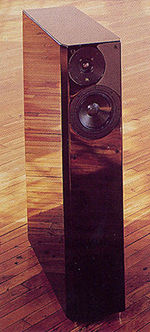| Columns Retired Columns & Blogs |
Focus Audio Signature Model 88 loudspeaker
A science-fiction parable I read too many years ago to remember who wrote it used the image of a glass jar stuffed with colored plastic spheres. The story's protagonist was asked whether the glass was full. "Of course," was his reply, whereupon a hidden faucet was turned, the jar filled up with water, and fish swam in the spaces between the balls.
 The high-end loudspeaker industry reminds me of that story. Given the literally hundreds of manufacturers in existence, each offering audiophiles a more or less complete line of speakers at every possible price point, how could there be possibly be room for even one more brand? Yet even as every market niche seems full, up springs another manufacturer, justifying its existence with products offering good or even better sound quality.
The high-end loudspeaker industry reminds me of that story. Given the literally hundreds of manufacturers in existence, each offering audiophiles a more or less complete line of speakers at every possible price point, how could there be possibly be room for even one more brand? Yet even as every market niche seems full, up springs another manufacturer, justifying its existence with products offering good or even better sound quality.
Such was the case with Focus Audio. I first encountered one of this new Canadian company's products at HI-FI '96, where their Signature Model 88 loudspeakers were being used with a Nagra-D, a dCS D/A converter, and Reference Line amplification. My main interest in the demonstration was that it was my first exposure to 24-bit data sampled at 96kHz, something Wes Phillips and I discuss at length elsewhere in this issue. But even as I found that I was not having to strain to hear the difference due to the digital signal bandwidth being doubled, it struck me that the speakers being used were something special. Accordingly, I requested a pair for review.
Design
At $8800/pair, the floorstanding 88 is the most expensive of Focus's three Signature models. Like the two smaller two-way Signature series speakers (the stand-mounted 68 and the floorstanding 78), it uses a soft-dome tweeter coupled with an Eton Nomex/Kevlar-coned midrange unit. However, it adds an 11" Eton Nomex/Kevlar-coned woofer to extend the bass to almost 20Hz, this driver mounted on the speaker's side nearest the room sidewall.
Conceptually, the big Focus is a high-performance minimonitor allied to a subwoofer in the same enclosure. Superficially, it resembles the NHT 3.3 in that it is much deeper than it is wide, and features a side-firing woofer. The latter speaker, however, uses two midrange units mounted above and below the tweeter, to the side of a strip of foam to affect the dispersion. The Model 88 mounts its single tweeter—an expensive Scanspeak "Revelator"—above and slightly to one side of the single 7" midrange unit. (The speakers are supplied as a mirror-imaged pair.) It also differs from the NHT speaker in that it needs to be used well away from room boundaries. The setup instructions in the comprehensive handbook, for example, recommend a position 3-4' away from the wall behind the speaker, and mention that the Model 88 is to be used in rooms with volumes of between 4000 and 7000 cubic feet.
The big Eton woofer is reflex-loaded with a port 4" in diameter and 12" deep on the rear panel, positioned just above the recessed panel that carries the terminal posts. The two pairs of posts are Cardas OFC/Tellurium types. The hardwired crossover is mounted to the terminal panel and appears to be second-order, with a Zobel network across the midrange/woofer terminals and a series resistor in the tweeter feed. Other than a nonpolarized electrolytic in the woofer filter, the circuit is implemented with polypropylene-dielectric capacitors—large values paralleled with smaller caps—and inductors wound with high-purity copper wire. The midrange and tweeter coils are air-cored. Component tolerances are said to be held to within 1%. The internal wiring, however, is relatively narrow-gauge.
The cabinet is made from 1" MDF, with the front baffle 2" thick. It is extensively braced and filled with polyester fiber. The finish is a black "piano" lacquer, which adds a subtle touch of luxury to what is visually a quite self-effacing loudspeaker. Small cloth grilles cover the tweeter and midrange unit. I left these off. The original review samples were supplied with SolidSteel aluminum cones. These have been replaced by hardened steel spikes that Focus believes are more consistent in producing good sound from the Model 88. All the serious listening was performed using these spikes to couple the speakers to the tile-on-concrete floor beneath the rug in my room.
Sound
I actually auditioned two pairs of the Focus 88s. Soon after I had set up the first pair, Focus e-mailed me to let me know that they had made some minor changes to the crossover in December '96 and that they were sending updated samples. I found the differences between the two pairs of speakers minimal. All my auditioning comments refer to the second pair, however.
- Log in or register to post comments




































